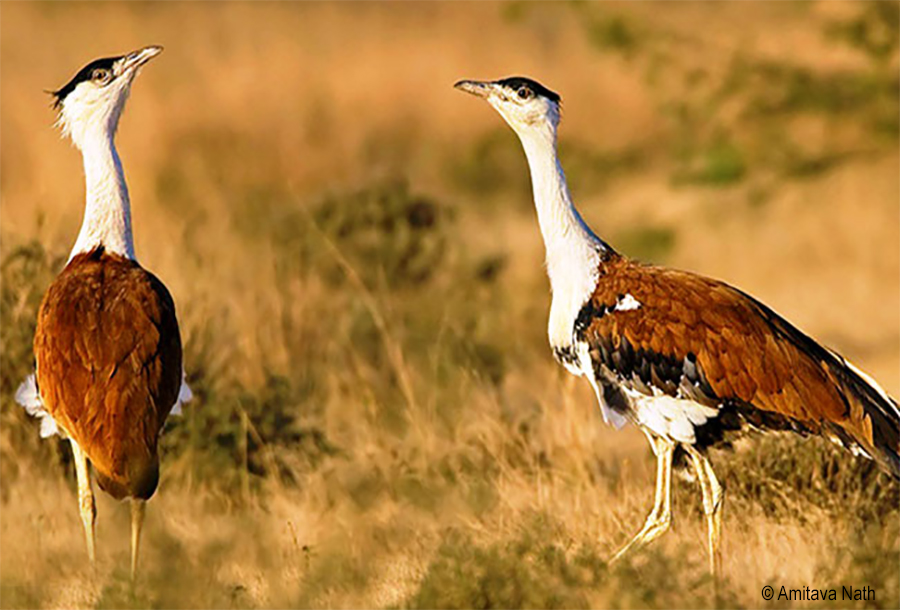
Introduction of Great Indian Bustard
Great Indian bustard (Scientific name :Ardeotis nigriceps) is a large bird with a horizontal body and belongs to the order Otidiformes and family is Otididae. long bare legs, giving it an ostrich like appearance, this bird is among the heaviest of the flying birds.
How to identify Great Indian bustard
This bird is among the heaviest of the flying birds. It has long bare legs which give it an ostrich like appearance. Its height is around 100 cms or 1 metre and wingspan is of 210-250 cm. Weight is 15-18 kg. The Great Indian bustard can easily be distinguished by its black crown on the forehead contrasting with the pale neck and head. The body is sandy buff and the wings are marked with black, brown and grey. During the breeding season a black breast band are seen in male. Female is smaller than the male and the head and neck are not pure white and the breast band is either rudimentary, broken or absent.
Habits and Habitats
Great Indian Bustards generally favor flat open landscapes with minimal visual obstruction and disturbance.The habitats of Great Indian Bustard is arid and semi-arid grasslands, open country with thorn scrub. It avoids irrigated areas and grasses taller than themselves and dense scrub like thickets. In the non-breeding season they frequent wide agro-grass scrub landscapes. In the breeding season they congregate in undisturbed grassland patches characterized by a mosaic of scantily grazed tall grass (below 50 cm).
Food
These birds are opportunist and omnivorous eaters. They live on variety food ranges widely depending on the seasonal availability. They feed on grass seeds, insects like grasshoppers and beetles, and sometimes even small rodents and reptiles.
Distribution
Earlier the great Indian bustard was found throughout Western India, spanning 11 states, as well as parts of Pakistan. Its stronghold was once the Thar desert in the north-west and the Deccan plateau of the peninsula. Today, its population is confined mostly to Rajasthan and Gujarat. Small population occur in Maharashtra, Karnataka and Andhra Pradesh.
Breeding and Nesting
Great Indian bustard breed mostly during the monsoon season between March and September. During breeding season territorial fights are seen between males which involve strutting next to each other. Male leap against each other with legs against each other and land down to lock the opponent’s head under their neck. Males have a gular pouch, which they inflate during courtship to produce a resonant booming mating call to attract females during breeding season and can be heard up to a distance of 500 metres. The tail is held cocked up over the body. The male also raises the tail and folds it on its back. The male is polygamous.Males are said to be solitary during the breeding season but form small flocks in winter.
Females lay a single egg on open ground. Males do not take any role in the incubation and care of the young. Young bird remain with the mother till the next breeding season.
Conservation Status
As stated earlier, once the Great Indian bustard was found throughout Western India. But today the worldwide population was estimated at perhaps less than 250 in 2008. In 2011 Birdlife International uplisted this species from Endangered to Critically Endangered. It has been listed in Schedule I of the Indian Wildlife (Protection)Act, 1972, in the CMS Convention and in Appendix I of CITES, as Critically Endangered on the IUCN Red List and the National Wildlife Action Plan (2002-2016). It has also been identified as one of the species for the recovery programme under the Integrated Development of Wildlife Habitats of the Ministry of Environment and Forests, Government of India.
Works to increase Great Indian Bustard population
The Great Indian bustard has been in deep trouble for a while. Once found across India’s grasslands and dry landscapes, the critically endangered bird is now down to just 160-odd individuals, most of them surviving in the Thar Desert in Rajasthan state.
Even in this last stronghold, survival is hard. Agricultural fields and a growing network of power lines and wind turbines have taken over their habitats, while predators like dogs destroy their eggs. In a last ditch effort, wildlife researchers along with the forest department have started a hunt for the birds’ eggs in Rajasthan to begin the process of captive breeding.
The Rajasathan High Court has been told by the state government that it has decided to set up two captive breeding centres for conservation of the Great Indian Bustard. The two places identified for setting up the breeding centres for the Rajasthan’s state bird are Sursan in Kota and Ramdeora in Jaisalmer
But it’s very difficult first to incubate the eggs, then to rear the chicks. Another problem is that whether the birds are able to breed or not. If they start breeding, then the researcher might have a population that they can start releasing in the wild again. The effort now is to create a founder population of breeding birds, chicks of which can probably be rewilded. So it’s going to be a very long process.
Author: Mr. Amitava Nath
